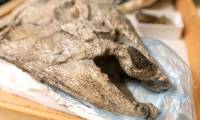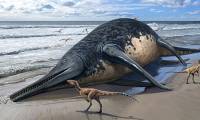
The largest salmon species ever discovered, Oncorhynchus rastrosus, can use its tusk-like teeth to compete with rivals, defend itself from predators, and dig nests.

Metal detectors have unearthed a miniature bronze portrait of Alexander the Great on an island in Denmark.

The expedition's leader said the fossil of Puentemys mushaisaensis, estimated to be about 1.5 meters long, was found in the mountainous municipality of Socha, northeastern

Six meters long and sporting a unique asymmetrical leather armor, the North African beast is a completely new species of the Stegosaur family.

Today's great white sharks are still much less dangerous than their newly unearthed ancestral sea monster.

A hundred-year-old weapons chest could help archaeologists understand the fire and explosion that sank the Danish king's flagship.

Archaeologists recently discovered a 12th-century tomb during an archaeological dig and found buried treasure with it.

The giant octopus was

first

All three newly discovered kangaroo species belong to the extinct kangaroo genus Protemnodon that lived on the Australian continent, between 5 million and 40,000 years ago.

According to experts, the fossil discovered by an 11-year-old girl on the beach in Somerset County, England, may belong to an ichthyosaur, the largest marine reptile that has ever

A study based on more than 3,200 modern Japanese human gene sequences has found genetic elements inherited from two extinct human species.

The four monsters that have just appeared belong to a species that has never been known in the world.

A group of researchers found fossils of giant ancient snakes that could have been longer than a school bus and weighed a ton.

On this beautiful island next to the International Date Line, ancient cities have appeared in a completely shocking way.
 The largest salmon species ever discovered, Oncorhynchus rastrosus, can use its tusk-like teeth to compete with rivals, defend itself from predators, and dig nests.
The largest salmon species ever discovered, Oncorhynchus rastrosus, can use its tusk-like teeth to compete with rivals, defend itself from predators, and dig nests. Metal detectors have unearthed a miniature bronze portrait of Alexander the Great on an island in Denmark.
Metal detectors have unearthed a miniature bronze portrait of Alexander the Great on an island in Denmark. The expedition's leader said the fossil of Puentemys mushaisaensis, estimated to be about 1.5 meters long, was found in the mountainous municipality of Socha, northeastern
The expedition's leader said the fossil of Puentemys mushaisaensis, estimated to be about 1.5 meters long, was found in the mountainous municipality of Socha, northeastern Six meters long and sporting a unique asymmetrical leather armor, the North African beast is a completely new species of the Stegosaur family.
Six meters long and sporting a unique asymmetrical leather armor, the North African beast is a completely new species of the Stegosaur family. Today's great white sharks are still much less dangerous than their newly unearthed ancestral sea monster.
Today's great white sharks are still much less dangerous than their newly unearthed ancestral sea monster. A hundred-year-old weapons chest could help archaeologists understand the fire and explosion that sank the Danish king's flagship.
A hundred-year-old weapons chest could help archaeologists understand the fire and explosion that sank the Danish king's flagship. Archaeologists recently discovered a 12th-century tomb during an archaeological dig and found buried treasure with it.
Archaeologists recently discovered a 12th-century tomb during an archaeological dig and found buried treasure with it. The giant octopus was
The giant octopus was first
first All three newly discovered kangaroo species belong to the extinct kangaroo genus Protemnodon that lived on the Australian continent, between 5 million and 40,000 years ago.
All three newly discovered kangaroo species belong to the extinct kangaroo genus Protemnodon that lived on the Australian continent, between 5 million and 40,000 years ago. According to experts, the fossil discovered by an 11-year-old girl on the beach in Somerset County, England, may belong to an ichthyosaur, the largest marine reptile that has ever
According to experts, the fossil discovered by an 11-year-old girl on the beach in Somerset County, England, may belong to an ichthyosaur, the largest marine reptile that has ever A study based on more than 3,200 modern Japanese human gene sequences has found genetic elements inherited from two extinct human species.
A study based on more than 3,200 modern Japanese human gene sequences has found genetic elements inherited from two extinct human species. The four monsters that have just appeared belong to a species that has never been known in the world.
The four monsters that have just appeared belong to a species that has never been known in the world. A group of researchers found fossils of giant ancient snakes that could have been longer than a school bus and weighed a ton.
A group of researchers found fossils of giant ancient snakes that could have been longer than a school bus and weighed a ton. On this beautiful island next to the International Date Line, ancient cities have appeared in a completely shocking way.
On this beautiful island next to the International Date Line, ancient cities have appeared in a completely shocking way.






















